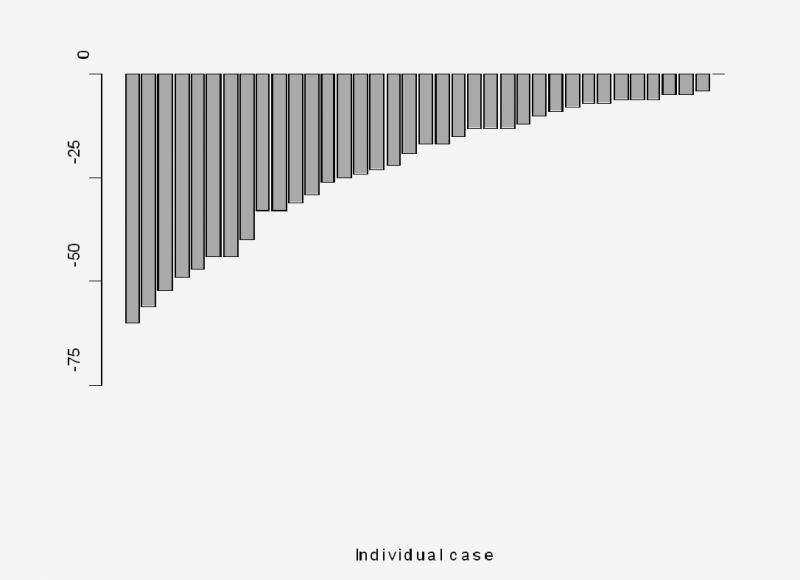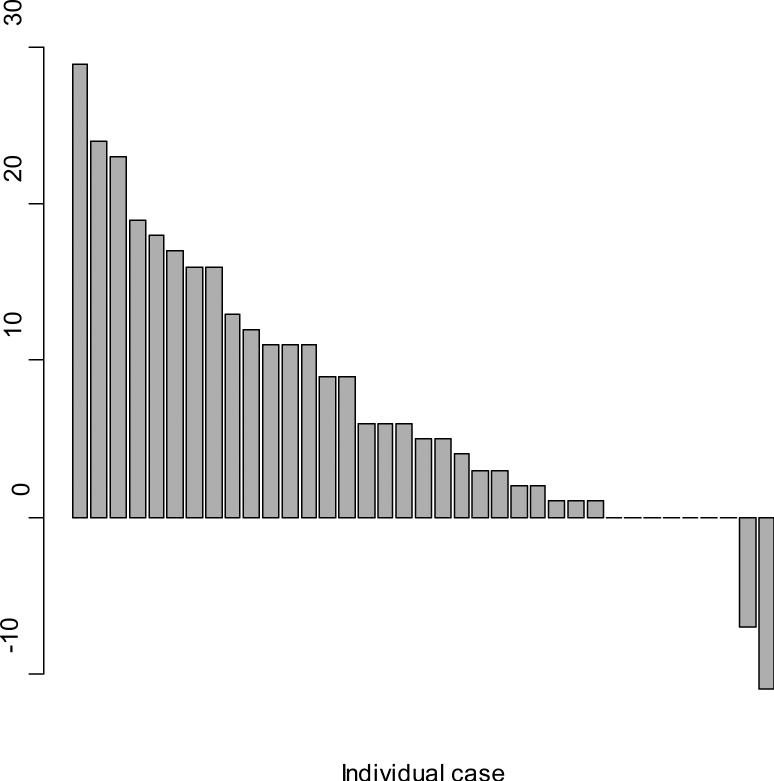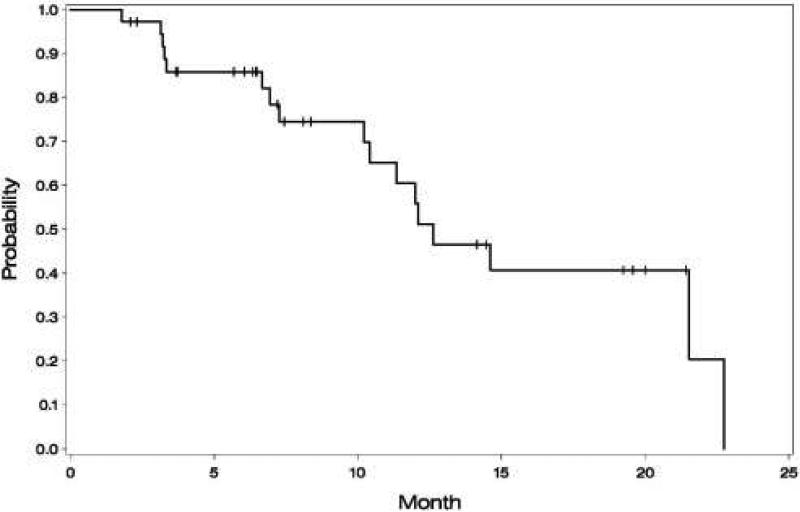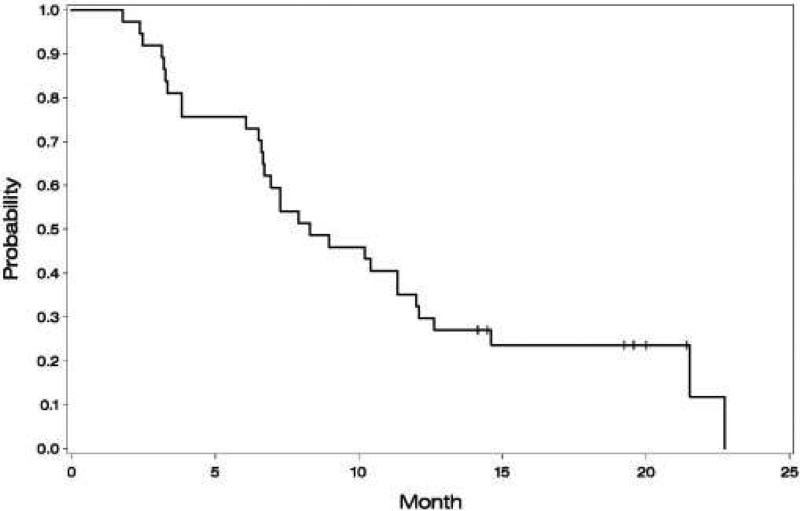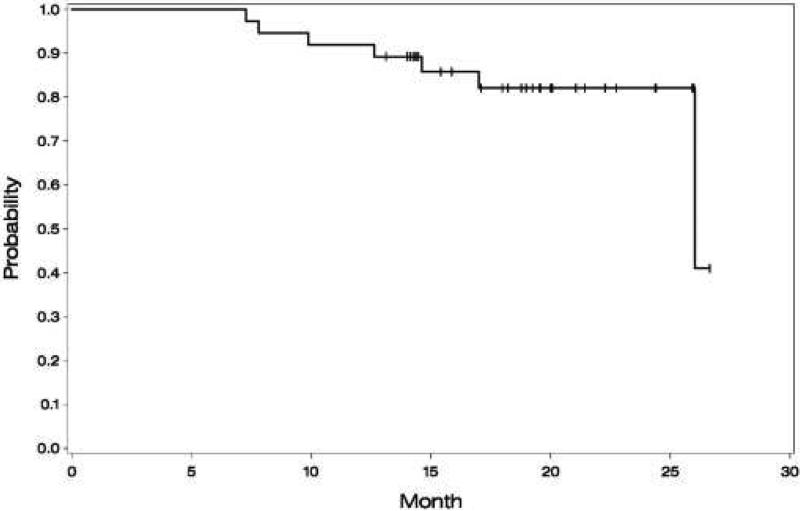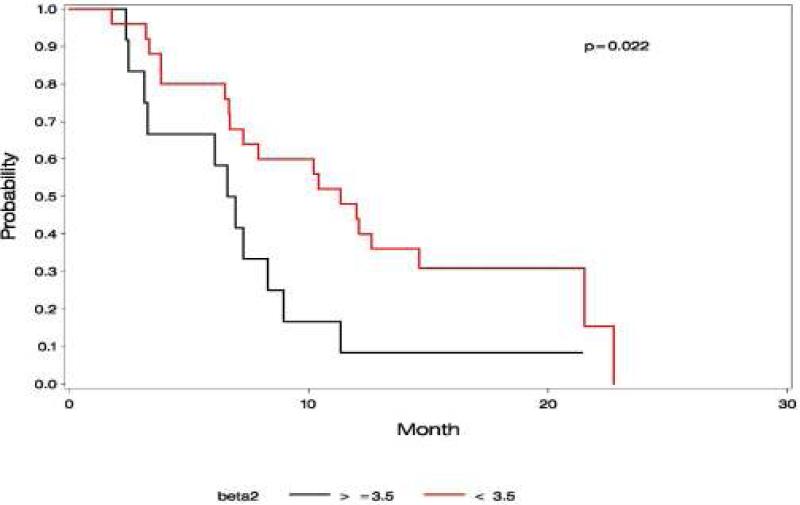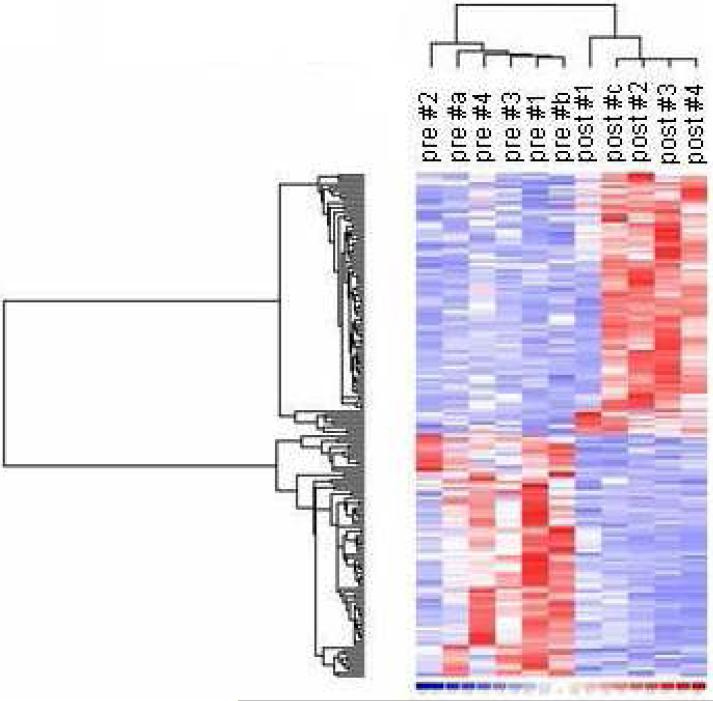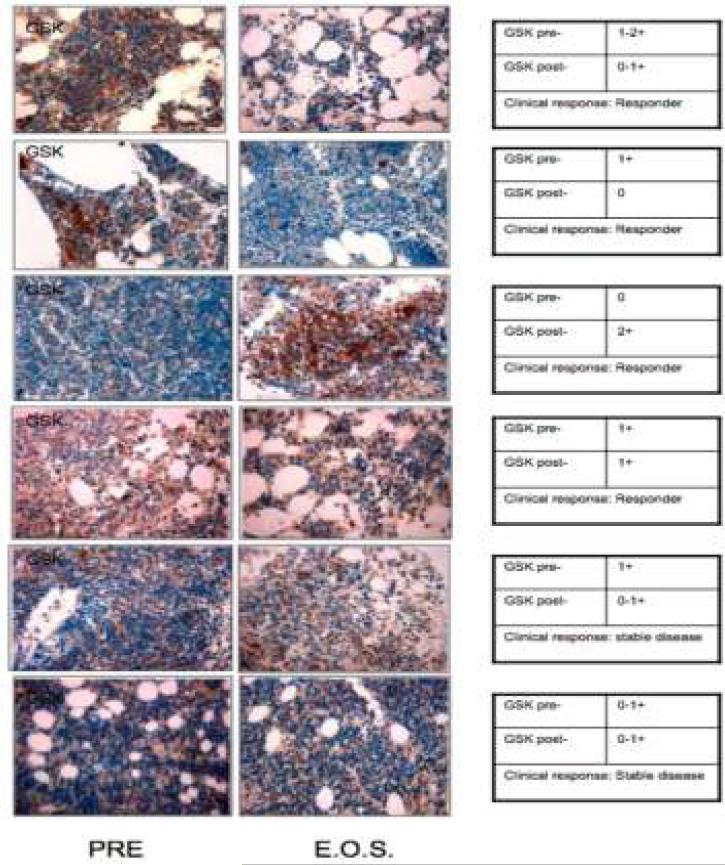Abstract
Background
Waldenstrom's Macroglobulinemia (WM) is a rare low-grade lymphoproliferative disorder. Based on preclinical studies, we conducted a phase II clinical trial testing the efficacy and safety of the Akt inhibitor perifosine in patients with relapsed/refractory WM.
Patients and Methods
Thirty-seven patients were treated with oral perifosine 150 mg daily for 6 cycles. Stable or responding patients were allowed to continue therapy until progression.
Results
The median age was 65 years (range, 44-82). The median number of prior therapy lines was 2 (range, 1-5). Of the 37 patients, 4 achieved partial response (11%), 9 minimal response (24%), and 20 showed stable disease (54%). The median progression-free survival was 12.6 months. Additionally, beta-2 microglobulin of >3.5mg/dL was associated with poor event-free survival, (p=0.002). Perifosine was generally well tolerated; adverse events related to therapy were cytopenias (grade 3-4, 13%), gastrointestinal symptoms (grade 1-2, 81%), and arthritis flare (all grades, 11%). Translational studies using gene expression profiling and immunohistochemistry showed perifosine inhibited pGSK activity downstream of Akt, and inhibited NF-kB activity.
Conclusion
Perifosine results in at least a minimal response in 35% of patients and a median progression-free survival of 12.6 months in patients with relapsed or relapsed/refractory WM, as well as in vivo inhibition of pGSK activity. The results of this study warrant further evaluation of perifosine in combination with rituximab or other active agents in patients with WM.
Keywords: Waldenstrom, macroglobulinemia, perifosine, akt, novel agent, clinical trial
INTRODUCTION
Waldenstrom's Macroglobulinemia (WM) is a distinct lymphoproliferative disorder characterized by bone marrow infiltration with lymphoplasmacytic cells, along with an IgM monoclonal gammopathy(1-4). Despite advances in the therapy of WM, the disease remains incurable, thereby necessitating the development of novel therapeutics(3, 5, 6). Current therapies used in the upfront or relapsed settings include alkylator agents (chlorambucil), nucleoside analogues, and rituximab(7-10). In the salvage setting, overall response rate (ORR) is in the range of 30-40%, with median response duration of 6 months to 1 year(8, 11). Therefore, development of therapies specifically targeting the malignant clone in WM, in these patients is a priority.
STATEMENENT OF TRANSLATIONAL RESEARCH.
Waldenstrom's Macroglobulinemia (WM) is a rare low-grade lymphoproliferative disorder. We conducted a phase II clinical trial testing the efficacy and safety of the Akt inhibitor perifosine in patients with relapsed/refractory WM. We also performed correlative studies to examine in vivo inhibition of Akt. Perifosine resulted in at least a minimal response in 35% and stable disease in 54% of patients. The median progression-free survival was 12.6 months. We were able to demonstrate in the majority of samples tested that there was a significant reduction of pGSK3/β at the protein level using immunohistochemistry. Similarly, we found that perifosine significantly inhibited the expression of multiple members of the NF-kB family of genes, confirming our in vitro studies showing activity of perifosine on this pathway. The results of this study warrant further evaluation of perifosine in combination with rituximab or other active agents in patients with WM.
Increased expression of Akt plays an important role on initiation and progression of malignancies, specifically lymphomas. The phosphatidylinositol-3, kinase (PI3K) pathway enhances cell survival by stimulating cell proliferation and inhibiting apoptosis(12-16). Akt, downstream of PI3K, regulates multiple signaling pathways controlling cell cycle, proliferation, and resistance to apoptosis(13, 15).
Perifosine (1,1-dimethyl-4 [(octadecyloxy)hydroxyphosphinyl]oxy]-piperidinium inner salt, Keryx Biopharmaceutical) is a novel Akt inhibitor belonging to a class of lipid-related compounds called alkylphospholipids(17, 18). Phase I and phase II studies have been conducted with perifosine(19). The most frequently observed toxicities were gastrointestinal events (nausea, vomiting, diarrhea) and fatigue. The determined phase II dose is 150 mg oral daily. We previously performed preclinical studies demonstrating perifosine specifically inhibits Akt in WM primary cells and cell lines(17, 18). Perifosine led to significant inhibition of proliferation and induction of apoptosis in WM cells in vitro, but not in normal donor peripheral blood and hematopoietic progenitors(20). Perifosine induced significant reduction in WM tumor growth in vivo in a subcutaneous xenograft model through inhibition of Akt phosphorylation and downstream targets(20). We also demonstrated that Akt pathway down-regulation inhibited migration and adhesion in vitro, and homing of WM tumor cells to the bone marrow microenvironment in vivo(20). Based on these studies, we tested the clinical and in vivo activity of perifosine in patients with relapsed, or relapsed/refractory WM.
PATIENTS AND METHODS
Patients
Study participants were at least 18 years of age with relapsed/refractory WM. Patients must have had prior therapy with at least one treatment regimen and any number of prior therapies was allowed. Patients must have had symptomatic disease requiring therapy for WM according to the consensus recommendations for WM(7). Patients had measurable monoclonal IgM immunoglobulin concentration on serum electrophoresis and IgM immunoglobulin protein twice the upper limit of normal by nephelometry, as well as the presence of lymphomplasmacytic cells in the bone marrow. Eligibility criteria included an Eastern Co-operative Oncology Group (ECOG) performance status of 2 or less, a serum concentration of AST or ALT < 3 times the upper limit of the normal range, a serum total bilirubin <2 times the upper limit of the normal range, a measured creatinine <2 times the upper limit of the normal range, a platelet count of ≥75,000/mm2, and an absolute neutrophil count of at least 1000/mm2. Exclusion criteria included cytotoxic chemotherapy ≤ 3 weeks, biologic therapy ≤ 2 weeks, or corticosteroids ≤ 2 weeks prior to registration. All patients gave written informed consent before entering the study, which was performed in accordance with the Declaration of Helsinki; approval was obtained from the institutional review board at each of the participating centers.
Study Design and Treatment
Patients received perifosine orally at 150 mg daily after food for 28-day cycles. Patients with progressive disease after two cycles were taken off therapy. Patients with stable or responsive disease continued on therapy. Participants received 6 cycles of therapy, and were allowed to stay on therapy until disease progression if they had continued clinical benefit or stable disease, (See Consort diagram). The primary objective was the proportion of patients with at least an MR and secondary endpoints included safety, event-free survival and progression-free survival.
Assessment of Efficacy
Tumor assessment was performed using the consensus panel recommendations(21, 22). Response included complete remission (CR), partial remission (PR) and minimal response (MR) using serum protein electrophoresis. Response was also assessed by IgM using nephlometry. Patients were assessed every 28 days for the first 12 months on therapy and every 3 months thereafter. Patients who came off therapy were monitored every 3 months until they progressed, were treated with another therapy, or died.
Assessment of Safety
Adverse events were assessed at each visit and graded according to the National Cancer Institute Common Toxicity Criteria (version 3.0) from the first dose until 30 days after the last dose of perifosine.
Immunohistochemistry
Bone marrow biopsies from 11 patients at pre-treatment, during therapy (at cycle 3), and at the end of therapy were fixed in Zenker's formalin, embedded in paraffin blocks, and sectioned. Sections were stained for pGSK3α/β (pGSK), (Cell Signaling Technology Inc, MA).
Gene expression profiling
Total RNA was isolated from primary CD19+ cells, which were isolated from bone marrow aspirates of patients before (N=6) and during therapy (cycle 3, N=5) using RNeasy kit (Qiagen), as described by the manufacturer, and analyzed with Affymetrix U133 plus 2.0 geneChips (Affymetrix). The normalization of arrays and calculation of expression values was done using the DNA-chip analyzer (dChip) program. Functional classification and biochemical pathway maps were evaluated using Database for Annotation, Visualization, and Integrated Discovery (DAVID) software.
Statistical Analysis
A two-stage design was used, with 17 eligible patients entered on the first stage and an additional 20 eligible patients added to the second stage if at least 4 of the 17 patients achieved a MR. Patient characteristics were summarized and compared between responders and non-responders using Fisher's exact test for binary endpoints and Wilcoxon Rank Sum test for continuous endpoints. Estimated response proportions were reported along with exact two-stage binomial 90% confidence intervals (CIs). Median time to response (TTR) and duration of response (DOR) were reported among responding patients. Estimates of time to progression (TTP), event-free survival (EFS), progression-free survival (PFS), and overall survival (OS) were calculated using Kaplan–Meier methodology. Cox proportional hazard model was used to evaluate the impact of multiple factors on time to event endpoints. All p-values are two-sided. Statistical analyses were performed using SAS statistical software (version 8.2, SAS Institute).
RESULTS
Patients and Treatment
From October 2006 to November 2007, 37 patients were enrolled in 2 centers. Table 1A shows selected characteristics and prior types of therapy for the 37 patients. The median age at enrollment was 65 years (range, 44-82). The median IgM level was 3,120 mg/dL (range, 870-8,480) and the median M spike by serum protein electrophoresis was 2.0 gm/dL (range, 0.5- 4.9). Only 3 (8%) patients had an IgM below 1000mg/dL and they had symptomatic disease requiring therapy such as progressive anemia with significant involvement in the bone marrow or bulky lymphadenopathy. The median hemoglobin at enrollment was 11.2 gm/dL (range, 7.0-14.9). Twelve (32% of patients had a hemoglobin <10.0gm/dL, and 25 (68%) had a hemoglobin <12.0 gm/dL). The median Beta- 2 microglobulin at enrollment was 2.9 mg/dL (range, 1.4-6.8). The median % bone marrow involvement was 70 (range, 10-95). There was evidence of disease in soft tissue assessment including organomegaly or lymphadenopathy in 24 patients (65%). Almost 50% of the patients were intermediate or high risk by the ISS-WM staging system at the time of enrollment.
Table 1A.
Baseline characteristics
| N | % | |
|---|---|---|
|
Gender, Male |
27 |
73 |
|
Median Age
|
65 |
range (44-82) |
|
Median Hemoglobin (g/dL)
|
11.2 |
range (7.0-14.9) |
| Anemia | ||
| Hb<10 (g/dL) | 12 | 32 |
| Hb<12 (g/dL) |
25 |
68 |
|
Median platelet.0
|
215 |
range (36-390) |
|
Median IgM (mg/dL)
|
3120 |
range (870-8480) |
| IgM>1000 mg/dL | 34 | 92 |
|
IgM <1000 mg/dL
|
3 |
8 |
|
Median M spike by SPEP
|
2.0 |
range (0.5-4.9) |
|
Median % bone marrow involvement
|
70 |
range (10-95) |
|
Evidence of Disease by CT scan
|
24 |
65 |
| Beta 2 microglobulin | ||
| >3.5 | 12 | 32 |
| >5.5 |
2 |
5 |
|
Median beta 2 microglobulin (mg/dL)
|
2.9 |
(1.4-6.8) |
| ISS-WM | ||
| Intermediate/high Risk | 19 | 51 |
| Low risk |
18 |
49 |
| ECOG PS | ||
| 0 | 34 | 92 |
| 1 and 2 |
3 |
8 |
| Disease Status | ||
| Relapsed | 18 | 49 |
| Refractory | 8 | 22 |
| Relapsed and refractory | 11 | 30 |
| No. of prior treatment | ||
| 1 | 12 | 32 |
| 2 | 10 | 37 |
| 3 | 6 | 16 |
| >3 | 9 | 25 |
| Prior therapy | ||
| Chlorambucil, Chlorambucil/Prednisone | 8 | 21.62 |
| 2CdA, Fludarabine, Pentostatin | 20 | 54.05 |
| CHOP, CVP, Cytoxan, Mitoxantrone. | 11 | 29.73 |
| Rituximab alone or with others | 31 | 83.78 |
| Prednisone, Dexamethasone, Solumedrol | 6 | 16.22 |
| Others such as bortezomib, sildenafil, melphalan, prednisone, and thalidomide | 9 | 24.32 |
Thirty-one patients (84%) received prior rituximab alone or in combination with other agents. The median duration of treatment with perifosine was 5.6 months (range 1.8-21.5+). A total of 21 patients (57%) completed the treatment duration with 6 or more cycles of therapy on perifosine.
Efficacy and time to event endpoint analysis
Of the 37 patients, 4 achieved partial response (11%), 9 achieved minimal response (24%), and 20 showed stable disease (54%), with only 4 patients who showed progressive disease while on therapy (11%), Table 1B. Among the 13 patients with MR/PR, 54% (n=7) were Low-risk by ISS-WM, 31% (n=4) were intermediate-risk and 15% were high- risk (n=2). The median time to first response was 2.0 months (range, 1.1-4.9) and the median time to best response was 2.8 months (1.1-21.4).
Table 1B.
Efficacy
| N=37 | % | CI | |
|---|---|---|---|
| Response by M spike | |||
| MR | 9 | 24 | (11.8,41.2) |
| PR | 4 | 11 | (3.0, 25.4) |
| SD | 20 | 54 | (36.9,70.5) |
| PD | 4 | 11 | (3.0, 25.4) |
| Response by IgM | |||
| MR | 11 | 30 | (15.9, 47.0) |
| PR | 3 | 8 | (0.7,18.2) |
| SD | 19 | 51 | (36.9,70.5) |
| PD | 4 | 11 | (3.0, 25.4) |
Responses based on IgM was similar to that observed by serum protein electrophoresis (Table 1B). The overall response rate (MR+PR) by paraprotein using IgM was 38%, 90% CI: 25-53. Patients with low IgM <1000 mg/dL (N=3) did not show response to therapy, 2 showed stable disease and one progressive disease.
The median decrease in IgM among all 37 patients was 650 mg/dl (range, 0-3370) and the median percent decrease in IgM in all 37 patients was 22 %(range, 4-60%), Figure 1A. The median improvement in hemoglobin was 0.6 gm/dL (range, −1 to 2.4 gm/dL) and the median percent increase in hemoglobin among all 37 patients was 5% (range, −11 to 29%), Figure 1B.
Figure 1A. Percent decrease in IgM frombaseline in all 37 patients.
The median decrease in IgM from baseline among all 37 patients was 650 mg/dl (range, 0-3370) and the median percent decrease in IgM in all 37 patients was 22 %(range, 0-60%).
Figure 1B. Percent change in hemoglobinfrom baseline in all 37 patients.
The median improvement in hemoglobin from baseline was 0.6 gm/dL (range, −1 to 2.4 gm/dL) and the median percent change in hemoglobin among all 37 patients was 5% (range, −11 to 29%).
Of the 37 patients, 17 progressed (4 with primary progression [PD], 5 progressed after stable disease, and 8 after responding to treatment), 13 started non-protocol therapy without documented progression, 2 died without documented PD but with next therapy, and 18 are still alive without documented PD (11 out of 18 started next therapy). Death occurred in 7 patients, all of whom were off perifosine at the time of death. Of these, 6 deaths occurred with causes due to progressive disease and complications related to subsequent therapies, and one death occurred due to a motor vehicle accident.
At a median follow-up of 19.5 months, the median time to progression of disease and progression free survival were similar among all 37 patients and were 12.6 months with a 90% C.I. (10.2 - 22.7) (Figure 2A). The median event-free survival was 8.3 months with a 90% C.I. (6.7 – 12.0) (Figure 2B). Primary progressive disease (progression while on therapy) occurred early with a median of 3.2 months. The median treatment duration is 5.6 months (range, 1.8− 21.5+). The median overall survival was 26 months, 90% C.I. (26.0 –, no estimate for upper limit) (Figure 2C).
Figure 2A. Progression Free Survival.
Progression free survival. The median time to progression and progression free survival were similar among all 37 patients and were at 12.6 months, 90% C.I. (10.2 – 22.7 months).
Figure 2B. Event free survival.
Event free survival. The median time to event free survival was 8.3 months, 90% C.I. (6.7 – 12.0 months)
Figure 2C. Overall survival.
Overall survival. Kaplan Meier curve for overall survival. The median overall survival was 26 months, 90% C.I. (26.0 – months, no estimate for upper limit). Death occurred in 7 patients.
Prognostic Factors
We also sought to investigate markers that influenced progression free survival including age, ISS-WM staging system, beta-2 microglobulin, number of previous therapies, or percent of lymphoplasmacytic cells in the bone marrow at enrollment. Of these variables, a significant difference PFS was detected for beta-2 microglobulin (p =0.03, hazard ratio =1.4). In addition, beta-2 microglobulin of >3.5 mg/dL was associated with a poor progression free survival in these patients (p=0.002, hazard ratio=2.4, Figure 2D).
Figure 2D. Theeffect of beta-2 microglobulin > 3.5 mg/dL on event free survival.
The effect of Beta-2 microglobulin >3.5mg/dL on event free survival. Beta-2 microglobulin of >3.5 mg/dL was associated with a worse event free survival in these patients (p=0.002, hazard ratio n=2.42).
Safety
The most common adverse events were gastrointestinal symptoms, fatigue, cytopenias, and flare of arthritis/joint effusions (Table 2). Overall, 5 patients experienced grade 3 or 4 anemia, 4 were unrelated to therapy and 1 was possibly related to therapy. Interestingly, arthritis/joint effusions occurred in 4 patients (three grades 1-2, and one grade 3). All of these patients had response to perifosine. The etiology of this event is not known and it did not appear to be due to hyperuricemia in all patients. Dose reductions to 100 mg occurred in 16 patients (43%) due to neutropenia, gastrointestinal symptoms, or arthritis.
Table 2.
Drug-related adverse events
| Toxicity type | G 1-2 | % | G 3-4 | % |
|---|---|---|---|---|
| Hematological toxicities | ||||
| Anemia | 24 | 65 | 1 | 3 |
| Leukocytes | 20 | 54 | 4 | 11 |
| Neutrophils | 18 | 49 | 4 | 11 |
| Thrombocytopenia | 3 | 8 | ||
| Gastrointestinal | ||||
| Nausea | 28 | 76 | ||
| Vomiting | 24 | 65 | ||
| Diarrhea | 30 | 81 | ||
| Gastritis/dyspepsia | 8 | 22 | ||
| Abdomen, pain | 5 | 14 | ||
| Musculoskeletal | ||||
| Arthritis | 3 | 8 | 1 | 3 |
| Visual | ||||
| Vision-blurred | 3 | 9 | 1 | 3 |
| Eye, pain | 2 | 5 | 1 | 3 |
| Infections | ||||
| Fever w/o neutropenia | 1 | 3 | ||
| Infection G0-2 neutropenia (lung, bronchi, others) | 2 | 5 | 1 | 3 |
| Constitutional | ||||
| Fatigue | 23 | 62 | 1 | 3 |
| Weight loss | 5 | 14 | ||
| Dizziness | 5 | 14 |
* related includes possibly, probably or definitely.
Translational studies
Gene expression analysis comparing pre- and post treatment samples
We first performed gene expression profiling in bone marrow-derived CD19+ cells of matched samples from 6 patients before therapy and of 5 patients during therapy (after 2 cycles of therapy). Supervised clustering analysis, performed by comparing pre- and post-treatment samples showed a significant separation at 1.5 fold difference in gene expression and p value of <0.05, Figure 3A. There were 162 genes significantly changed in expression in response to perifosine. We found reduced expression of several genes involved in the adhesion and migration processes, as well as regulators of the NF-kB pathway, Table 3. Interestingly, MAPK family genes showed increased expression in response to perifosine. Statistical correlation with clinical response was not performed given the small number of samples analyzed.
Figure 3A. Supervised clustering of gene expression profiling of pre-treatment versus post-treatment samples.
Supervised clustering of gene expression profiling of pre-treatment vs. post-treatment samples. Purified cRNA (15 mg) isolated from primary WM cells was hybridized to HG-U133Plus2.0 GeneChip (Affymetrix). Supervised clustering analysis in 6 pre- and 5 post-treatment patients. Fold change is shown by the intensity of induction (red) or suppression (blue) (p<0.05). Samples 1, 2, 3 and 4 have matching pre- and post-treatment samples, while samples a and b were available for pre-treatment only and sample c was available in post-treatment only.
Table 3.
Genes that showed changed in expression in response to perifosine
| PERIFOSINE-DOWNREGULATED GENES | ||
|---|---|---|
| AFFY_ID |
DAVID Gene Name |
Category |
| 240690_at | Hypothetical protein DKFZP761P0423 | Tyrosine protein kinases |
| 240613_at | Janus Kinase 1 | |
| 240850_at |
Dual-specificity tyrosine-Phosphorylation regulated kinase 1A |
|
| 238735_at | Transcription factor 12 | Transcription factors |
| 215164_at | Transcription factor 4 | |
| 1570299_at, 244414_at, | Mastermind-like 2 | |
| 232333_at | Regulatory factor X, 3 | |
| 232791_at, 240867_at | B-cell CLL/Lymphoma 11A | |
| 1559078_at |
|
|
| 242572_at | GAB1 (GRB2-associated binding protein 1) | Adhesion and migration |
| 244061_at |
ARHGAP15 (Rho GTPase activating protein 15) |
|
| 237001_at | NIBP (NIK and IKK beta binding protein) | NF-kB activators |
| 202987_at | TRAF3IP2 (TRAF3 interacting protein 2) | |
| 243450_at |
AKAP13 (A kinase anchor protein 13) |
|
| 232210_at, 232614_at |
BCL2( B-cell CLL/lymphoma 2) |
Anti-apoptotic protein |
|
PERIFOSINE-UPREGULATED GENES
| ||
| 201538_s_at | DUSP3 (dual specificity phosphatase 3) | Growth factor inhibitors |
| 207704_s_at, 210872_x_at |
GAS7 (growth arrest specific 7) |
|
| 244652_at |
Immunoglobulin superfamily, member 2 |
Tyrosine kinase inhibitors |
| 208602_x_at | cd6 antigen | MAPK activators |
Regulation of GSK signaling by perifosine
Given that our previous studies show total Akt does not change in response to perifosine and the changes only occur at the post-translational level at phosphorylation, we therefore investigated whether perifosine inhibits pGSK activity in vivo using imunohistochemistry. Phosphorylation of GSK occurs downstream of Akt and indicates Akt kinase activity(20). Immunohistochemistry was performed on 7 matched samples from pre-therapy and on their corresponding samples after 2 cycles of therapy and at the end of treatment. As shown in Figure 3B, there was an increased expression of pGSK3 in most of the samples tested (5/7), and a reduction in the level of pGSK in 5/7 post-treatment samples at the end of study, indicating that pGSK was inhibited in response to perifosine therapy. Statistical correlation with response was not performed given the small number of samples analyzed.
Figure 3B. Immunohistochemistry of phospho-GSK (pGSK) in pre - and post-treatment samples.
Immunohistochemistry of phospho-GSK in pre- and post-treatment samples. Scoring was performed by an independent pathologist, who was blinded to the clinical results. Each sample was given a score of 0 (no staining), 1 (weak staining), 2 (moderate staining) or 3 (strong staining of tumor cells) depending on the intensity of pGSK staining in the lymphoplasmacytic cells. For each sample, a table was placed with the score given for the pre-and post-treatment samples and the corresponding clinical response observed by monoclonal protein in these patients. Samples at cycle 3 were also obtained and showed similar results to the EOS samples and therefore, were not included in the figure.
Discussion
In this phase II study, we showed that the 35% of the patients achieved at least a MR to single agent perifosine, with another 54% of patients showing stabilization of their disease progression while on therapy and 11% of patients demonstrated progression. Other targeted therapeutic agents that have demonstrated efficacy in WM include thalidomide, bortezomib and alemtuzumab(8, 23-25). The response rate of MR and better using these agents ranges between 25-80%(8, 23-25). Unfortunately, some of these agents have a high toxicity profile such as Alemtuzumab therapy in WM(26-28). The use of bortezomib as a single agent in WM has been tested in relapsed WM(26, 27, 29). Chen et al(26) treated 27 patients with bortezomib in both untreated (44%) and previously treated (56%) patients with WM. The percentage of patients with MR or better to bortezomib was 78%, with major responses (PR or better) observed in 44% of patients, however, sensory neuropathy occurred in 20/27 patients, 5 with grade >3, and occurred following 2-4 cycles of therapy. In addition, the time to progression was relatively short in studies using single agent bortezomib, with a median time to progression of 7.9 months in the study by Treon et al(27). Therefore, there is need to develop therapeutic agents that do not cause neuropathy and lead to longer progression-free survival in this patient population with relapsed/refractory WM.
The results of this study show promising activity of this agent, especially as it was used in patients with relapsed or refractory symptomatic disease. In this study, 41% of these patients had 3 or more lines of prior therapy, which including nucleoside analogues, alkylating agents and rituximab. The median % involvement of the bone marrow with lymphoplasmacytic cells was 70% and 65% of patients had organomegaly or lymphadenopathy by CT scan measurement. These numbers are significantly higher compared to the recent review of 365 patients who presented with WM where patients usually have 30% involvement in the bone marrow and only 10-15% organomegaly or lymadenopathy(30). All of the patients had to demonstrate symptomatic disease requiring therapy at the time of enrollment on this study according to the second consensus recommendations for therapy for WM(7). Although ISS-WM was not described in patients with relapsed or refractory WM(31), 51% of the patients on our study had intermediate or high risk ISS-WM at the time of enrollment.
Responses were durable and occurred rapidly. The median time to progression and progression-free survival was 12.6 months (90% C.I. (10.2 - 22.7)) with a median follow-up of 19.5 months. This is relatively long compared to other targeted agents used in a similar population of relapsed WM such as bortezomib where the median time to progression was only 7.9 months in the study by Treon et al(27). This study represents one of the first phase II clinical trial showing activity of single agent perifosine in hematological malignancies. Based on the safety and activity of single agent perifosine in this study and our preclinical studies of its combination with rituximab and bortezomib(32), we believe that perifosine should be evaluated in combination with other active agents in WM such as rituximab or bortezomib in future clinical trials.
In this study, we found that elevated beta-2 microglobulin correlated poorly with progression-free survival. Prior studies have evaluated the prognostic relevance of this protein in newly diagnosed patients with WM(31), but have not described its relevance in the relapsed setting. This study, therefore, indicates that elevated beta-2 microglobulin is an important marker to be assessed in future clinical trials, even in patients with relapsed disease.
We were not able to identify prognostic significance for ISS-WM in this relapsed population treated with perifosine. The ISS-WM was described in newly diagnosed previously untreated patients who were subsequently treated with alkylating agents and nucleoside analogues(31). In the current study, patients had relapsed or refractory WM with 41% of these patients having 3 or more prior lines of therapy. Most of the patients in this study received prior rituximab alone or in combinations. In addition, more than 50% of the patients received nucleoside analogues. The use of chlorambucil in this study (20%) was not as high as in study used to assess WM-ISS in WM(31). This difference may be due to practice differences between the US and Europe as alkylating agents such as chlorambucil are not widely used in the US compared to Europe. We cannot compare the patient population with relapsed and refractory WM in this trial to newly diagnosed untreated patients with WM in the original WM-ISS staging. In our current study of patients with relapsed or refractory WM who were treated with perifosine, we were unable to identify a prognostic significance for ISS-WM. However, beta 2 microglobulin correlated with poor prognosis. Future studies to further examine the role of ISS-WM as a prognostic indicator in relapsed WM are warranted.
Perifosine was generally well tolerated with minimal grade 3 and 4 toxicities. The main side effects were cytopenias and gastronintestinal toxicities. Dose reduction improved the degree of gastrointestinal toxicities and current studies using perifosine are evaluating doses of 100 or 50 mg. Interestingly, arthritis in the form of large joint effusions, including knee or elbow, occurred in 4 patients. These patients showed response to perifosine. The etiology of toxicity is not well known and was not observed in previous studies with perifosine. Future studies are warranted to identify the underlying mechanism of arthritic flare in patients receiving perifosine.
To further investigate the in vivo activity of perifosine in WM, we performed gene expression profiling and immunohistochemistry, and identified a signature that differentiated samples of pre- versus post-treatment. The most differentially expressed genes were regulators of adhesion. This highlights the significant effect of perifosine on adhesion, potentially through the activity of this class of agents on lipid rafts. Recent studies have shown that this class of agents can also induce apoptosis through their activity on the lipid rafts(33).
We next examined the activity of perifosine in vivo on the Akt signaling pathway. These studies were designed to ask the question, “did we hit the target in vivo?” Although the sample size was small, we were able to demonstrate in the majority of samples tested, there was a significant reduction of pGSK3/β at the protein level using immunohistochemistry. Similarly, we found that perifosine significantly inhibited the expression of multiple members of the NF-kB family of genes, confirming our in vitro studies showing activity of perifosine on this pathway.
In summary, we conducted a phase II clinical trial of perifosine in WM and showed single agent perifosine induces at least a MR in 35% of patients with relapsed or refractory disease, stable disease in 54% and a median progression-free survival of over 1 year. Future studies using this agent in combination with rituximab or other agents active in WM are warranted.
Acknowledgement
We would like to thank Jennifer Stedman for editing and reviewing the manuscript.
Supported in part by R21 CA126119-01, International Waldenstrom Macroglobulinemia Foundation (IWMF), Michelle and Steven Kirsch lab for Waldenstrom Macroglobulinemia, and Keryx Biopharmaceutical Inc.
References
- 1.Dimopoulos MA, Panayiotidis P, Moulopoulos LA, et al. Waldenstrom's macroglobulinemia: clinical features, complications, and management. J Clin Oncol. 2000;18:214–6. doi: 10.1200/JCO.2000.18.1.214. [DOI] [PubMed] [Google Scholar]
- 2.Ghobrial IM, Witzig TE. Waldenstrom macroglobulinemia. Curr Treat Options Oncol. 2004;5:239–247. doi: 10.1007/s11864-004-0015-5. [DOI] [PMC free article] [PubMed] [Google Scholar]
- 3.Dimopoulos MA, Kyle RA, Anagnostopoulos A, Treon SP. Diagnosis and management of Waldenstrom's macroglobulinemia. J Clin Oncol. 2005;23:1564–1577. doi: 10.1200/JCO.2005.03.144. [DOI] [PubMed] [Google Scholar]
- 4.Owen RG, Treon SP, Al-Katib A, Fonseca R, Greipp PR, McMaster ML, Morra E, Pangalis GA, San Miguel JF, Branagan AR, Dimopoulos MA. Clinicopathological definition of Waldenstrom's macroglobulinemia: consensus panel recommendations from the Second International Workshop on Waldenstrom's Macroglobulinemia. Semin Oncol. 2003;30:110–115. doi: 10.1053/sonc.2003.50082. [DOI] [PubMed] [Google Scholar]
- 5.Ghobrial IM, Gertz MA, Fonseca R. Waldenstrom macroglobulinaemia. Lancet Oncol. 2003;4:679–685. doi: 10.1016/s1470-2045(03)01246-4. [DOI] [PubMed] [Google Scholar]
- 6.Kyle RA, Treon SP, Alexanian R, et al. Prognostic markers and criteria to initiate therapy in Waldenstrom's macroglobulinemia: consensus panel recommendations from the Second International Workshop on Waldenstrom's Macroglobulinemia. Semin Oncol. 2003;30:116–120. doi: 10.1053/sonc.2003.50038. [DOI] [PubMed] [Google Scholar]
- 7.Gertz MA, Anagnostopoulos A, Anderson K, et al. Treatment recommendations in Waldenstrom's macroglobulinemia: consensus panel recommendations from the Second International Workshop on Waldenstrom's Macroglobulinemia. Semin Oncol. 2003;30:121–126. doi: 10.1053/sonc.2003.50039. [DOI] [PubMed] [Google Scholar]
- 8.Treon SP, Morel P, Leblond V, Fermand JP. Report of the Third International Workshop on Waldenstrom's macroglobulinemia. Clin Lymphoma. 2005;5:215–6. doi: 10.3816/clm.2005.n.001. [DOI] [PubMed] [Google Scholar]
- 9.Treon SP, Emmanouilides C, Kimby E, et al. Extended rituximab therapy in Waldenstrom's macroglobulinemia. Ann Oncol. 2005;16:132–8. doi: 10.1093/annonc/mdi022. [DOI] [PubMed] [Google Scholar]
- 10.Dimopoulos MA, O'Brien S, Kantarjian H, et al. Fludarabine therapy in Waldenstrom's macroglobulinemia. Am J Med. 1993;95:49–52. doi: 10.1016/0002-9343(93)90231-d. [DOI] [PubMed] [Google Scholar]
- 11.Dimopoulos MA, Weber D, Delasalle KB, et al. Treatment of Waldenstrom's macroglobulinemia resistant to standard therapy with 2-chlorodeoxyadenosine: identification of prognostic factors. Ann Oncol. 1995;6:49–52. doi: 10.1093/oxfordjournals.annonc.a059040. [DOI] [PubMed] [Google Scholar]
- 12.Cantrell DA. Phosphoinositide 3-kinase signalling pathways. J Cell Sci. 2001;114:1439–1445. doi: 10.1242/jcs.114.8.1439. [DOI] [PubMed] [Google Scholar]
- 13.Fresno Vara JA, Casado E, de Castro J, et al. PI3K/Akt signalling pathway and cancer. Cancer Treat Rev. 2004;30:193–204. doi: 10.1016/j.ctrv.2003.07.007. [DOI] [PubMed] [Google Scholar]
- 14.Hennessy BT, Smith DL, Ram PT, et al. Exploiting the PI3K/AKT pathway for cancer drug discovery. Nat Rev Drug Discov. 2005;4:988–1004. doi: 10.1038/nrd1902. [DOI] [PubMed] [Google Scholar]
- 15.Pene F, Claessens YE, Muller O, et al. Role of the phosphatidylinositol 3-kinase/Akt and mTOR/P70S6-kinase pathways in the proliferation and apoptosis in multiple myeloma. Oncogene. 2002;21:6587–97. doi: 10.1038/sj.onc.1205923. [DOI] [PubMed] [Google Scholar]
- 16.Dancey JE. Molecular targeting: PI3 kinase pathway. Ann Oncol. 2004;15(Suppl 4):iv233–239. doi: 10.1093/annonc/mdh932. [DOI] [PubMed] [Google Scholar]
- 17.Hideshima T, Catley L, Yasui H, et al. Perifosine, an oral bioactive novel alkylphospholipid, inhibits Akt and induces in vitro and in vivo cytotoxicity in human multiple myeloma cells. Blood. 2006 doi: 10.1182/blood-2005-08-3434. [DOI] [PMC free article] [PubMed] [Google Scholar]
- 18.Ruiter GA, Zerp SF, Bartelink H, et al. Anti-cancer alkyllysophospholipids inhibit the phosphatidylinositol 3-kinase-Akt/PKB survival pathway. Anticancer Drugs. 2003;14:167–173. doi: 10.1097/00001813-200302000-00011. [DOI] [PubMed] [Google Scholar]
- 19.Crul M, Rosing H, de Klerk GJ, et al. Phase I and pharmacological study of daily oral administration of perifosine (D-21266) in patients with advanced solid tumours. Eur J Cancer. 2002;38:1615–21. doi: 10.1016/s0959-8049(02)00127-2. [DOI] [PubMed] [Google Scholar]
- 20.Leleu X, Jia X, Runnels J, et al. The Akt pathway regulates survival and homing in Waldenstrom macroglobulinemia. Blood. 2007;110:4417–26. doi: 10.1182/blood-2007-05-092098. [DOI] [PMC free article] [PubMed] [Google Scholar]
- 21.Kimby E, Treon SP, Anagnostopoulos A, et al. Update on recommendations for assessing response from the Third International Workshop on Waldenstrom's Macroglobulinemia. Clin Lymphoma Myeloma. 2006;6:380–3. doi: 10.3816/CLM.2006.n.013. [DOI] [PubMed] [Google Scholar]
- 22.Weber D, Treon SP, Emmanouilides C, et al. Uniform response criteria in Waldenstrom's macroglobulinemia: consensus panel recommendations from the Second International Workshop on Waldenstrom's Macroglobulinemia. Semin Oncol. 2003;30:127–31. doi: 10.1053/sonc.2003.50037. [DOI] [PubMed] [Google Scholar]
- 23.Dimopoulos MA, Zomas A, Viniou NA, et al. Treatment of Waldenstrom's macroglobulinemia with thalidomide. J Clin Oncol. 2001;19:3596–601. doi: 10.1200/JCO.2001.19.16.3596. [DOI] [PubMed] [Google Scholar]
- 24.Hunter Z, Branagan A, Treon ST, et al. Campath-1H in Waldenström's Macroglobulinemia. Blood. 2004 November 16;104(11) Volume 104. 2004. Abstract. [Google Scholar]
- 25.Treon S, Hunter Z, Matous J, et al. Phase II Study of Bortezomib in Waldenstrom's Macroglobulinemia: Results of WMCTG Trial 03-248. Blood. 2005;106 Abstract. [Google Scholar]
- 26.Chen CI, Kouroukis CT, White D, et al. Bortezomib Is Active in Patients With Untreated or Relapsed Waldenstrom's Macroglobulinemia: A Phase II Study of the National Cancer Institute of Canada Clinical Trials Group. J Clin Oncol. 2007 doi: 10.1200/JCO.2006.07.8659. [DOI] [PubMed] [Google Scholar]
- 27.Treon SP, Hunter ZR, Matous J, et al. Multicenter clinical trial of bortezomib in relapsed/refractory Waldenstrom's macroglobulinemia: results of WMCTG Trial 03-248. Clin Cancer Res. 2007;13:3320–25. doi: 10.1158/1078-0432.CCR-06-2511. [DOI] [PubMed] [Google Scholar]
- 28.Hunter Z, Boxer M, Kahl B, et al. Phase II study of alemtuzumab in lymphoplasmacytic lymphoma: results of WMCTG trial 02-079. J Clin Oncol. 2006;24:427. [abstract] [Google Scholar]
- 29.Dimopoulos MA, Anagnostopoulos A, Kyrtsonis MC, et al. Treatment of relapsed or refractory Waldenstrom's macroglobulinemia with bortezomib. Haematologica. 2005;90:1655–58. [PubMed] [Google Scholar]
- 30.Treon SP. How I treat Waldenstrom's macroglobulinemia. Blood. 2009 doi: 10.1182/blood-2009-05-174359. [DOI] [PubMed] [Google Scholar]
- 31.Morel P, Duhamel A, Gobbi P, et al. International prognostic scoring system for Waldenstrom's macroglobulinemia. Blood. 2009 doi: 10.1182/blood-2008-08-174961. [DOI] [PubMed] [Google Scholar]
- 32.Leleu X, Eeckhoute J, Jia X, et al. Targeting NF-{kappa}B in Waldenstrom macroglobulinemia. Blood. 2008 doi: 10.1182/blood-2007-09-115170. [DOI] [PMC free article] [PubMed] [Google Scholar]
- 33.Van der Luit AH, Vink SR, Klarenbeek JB, et al. A new class of anticancer alkylphospholipids uses lipid rafts as membrane gateways to induce apoptosis in lymphoma cells. Mol Cancer Ther. 2007;6:2337–45. doi: 10.1158/1535-7163.MCT-07-0202. [DOI] [PubMed] [Google Scholar]



